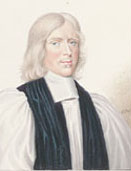
Eccleshall Castle is located in Eccleshall, Staffordshire, England. It was originally built in the 13th century. It is a Scheduled Ancient Monument and a Grade II* listed building.

Roger Northburgh was a cleric, administrator and politician who was Bishop of Coventry and Lichfield from 1321 until his death. His was a stormy career as he was inevitably involved in many of the conflicts of his time: military, dynastic and ecclesiastical.

Eccleshall is a town and civil parish in the Stafford district, in the county of Staffordshire, England. It is located seven miles northwest of Stafford, and six miles west-southwest of Stone. Eccleshall is twinned with Sancerre in France.

William Talbot was an English Anglican bishop. He was Bishop of Oxford from 1699 to 1715, Bishop of Salisbury from 1715 to 1722 and Bishop of Durham from 1722 to 1730.

Lawrence Booth served as bishop of Durham and lord chancellor of England, before being appointed archbishop of York.

Robert Wright (1560–1643) was an English bishop, first holding the see of Bristol and then the see of Lichfield and Coventry. He died at an episcopal palace, under siege in the First English Civil War.

Edward Chandler was the Bishop of Durham, and resided at Durham Castle.
William Lloyd may refer to:

James Cornwallis, 4th Earl Cornwallis was a British clergyman and peer.

John Wynne was Bishop of St Asaph (1715–1727) and of Bath and Wells (1727–1743), having previously been principal of Jesus College, Oxford (1712–1720).
Erasmus Saunders was a Welsh priest and writer.
James Fleetwood was an English clergyman and Bishop of Worcester.

John Hough was an English bishop. He is best known for the confrontation over his election as President at Magdalen College, Oxford that took place at the end of the reign of James II of England.
William Overton was an English bishop.
William Lloyd was a Welsh-born Anglican bishop. He was deprived of his see in 1691 for being a non-juror.
Bishop Lloyd may refer to:
Edward Jones (1641–1703), was a Welsh Anglican bishop who served as Bishop of Cloyne and Bishop of St Asaph.
Robert de Stretton was Bishop of Coventry and Lichfield following the death of Roger Northburgh in 1358. A client of Edward, the Black Prince, he became a "notorious figure" because it was alleged that he was illiterate, although this is now largely discounted as unlikely, as he was a relatively efficient administrator.
This article is about the particular significance of the year 1717 to Wales and its people.
Jonathan Newey (c1637-1716) was curate of Kinver (1665-1716).










